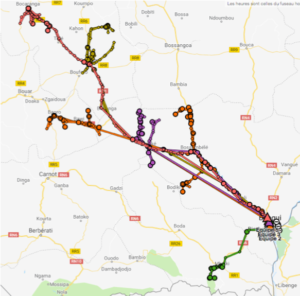Since February 2019, IPIS is partnering with the Artisanal Mining and Property Rights (AMPR) project from the U.S. Agency for International Development (USAID) to increase awareness and understanding of the opportunities and challenges of establishing responsible gold supply chains in the Central African Republic (CAR). As part of this project, IPIS is supporting the Ministry of Mines in mapping artisanal mining sites in western CAR (Nana-Mambéré, Ombella-M’Poko, Ouham-Pendé, Lobaye, Sangha-Mbaéré, Mambéré-Kadeï, Ouham…).
Following the recruitment of enumerators and a four-day training held in Bangui, IPIS field teams, consisting of 5 pairs of one member from the civil society organization and one focal point from the Kimberley Process, conducted their first field deployment in order to map artisanal mining sites in Western CAR. 192 mining sites were visited during an intense 21-days field mission.

About 55 000 miners were estimated working on the visited sites, for an average of 290 miners per site. A mining site in Western CAR is usually understood as a combination of several chantiers within a certain proximity. On average, 15 chantiers were reported on site, which means that about 20 workers were active on each chantier. Of course, these preliminary numbers will be refined at the end of the second field data collection cycle which is currently ongoing.
IPIS researchers Guillaume de Brier, Alexandre Jaillon and IPIS national focal point Jean-François Thalo conducted a field mission to Bozoum in order to visit gold mining sites previously visited by a team to test hypotheses on revenue and working conditions as well as to gather quantitative information through discussion and interviews with miners and members of the local community.



